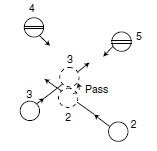Definition of misconduct 1. A player is guilty of misconduct if he:
(a) trips, kicks or strikes another player.
(b) when effecting or attempting to effect a tackle makes contact with the head or neck of an opponent intentionally, recklessly or carelessly.
(c) drops knees first on to an opponent who is on the ground
(d) uses any dangerous throw when effecting a tackle.
(e) deliberately and continuously breaks the Laws of the Game.
(f) uses offensive or obscene language.
(g) disputes a decision of the Referee or Touch Judge.
(h) re-enters the field of play without the permission of the Referee or a Touch Judge having previously temporarily retired from the game.
(i) behaves in any way contrary to the true spirit of the game.
(j) deliberately obstructs an opponent who is not in possession.
(k) Uses a shoulder charge on an opponent.
ALSO NOTE
Law breakers 1. (e) When a player repeatedly breaks the Laws in a ‘specialist’ position, e.g. hooker or scrum half, the Referee should, when administering the final caution, inform the player’s captain. The latter may, at his discretion, move the offending player to another position. The Referee cannot order a player to change his position.
Dangerous throw (d) If, in any tackle of, or contact with, an opponent that player is so lifted that he is placed in a position where it is likely that the first part of his body to make contact with the ground will be his head or neck (“the dangerous position”), then that tackle or contact will be deemed to be a dangerous throw unless, with the exercise of reasonable care, the dangerous position could not have been avoided.
Explain reason for penalty (g) A player may ask the Referee the reason why a penalty kick has been given provided he does so respectfully.
Delay restart of play (i) To deliberately delay the restart of play from the goal line, 20 metre line or halfway line constitutes misconduct for the purposes of this rule.
Obstruction after kick (j) A common form of obstruction occurs when a player, after kicking the ball forward, is tackled or impeded by an opponent. However, a tackler cannot be expected to delay making a tackle because the player in possession might decide to kick the ball. The onus is on the kicker to get his kick in before his opponent commits himself to the tackle.
The player in possession has delayed kicking the ball until the tackler has commenced to dive. The tackler should not be penalised.
The ball has been kicked before the opponent commits himself to the tackle. He should be penalised if he obstructs the kicker.

Obstructing passing movement Obstruction sometimes occurs in a passing movement as follows:–
It is permissible for player 4, after passing the ball, to slow down in order to position himself for a return pass from player 5. He must give ‘right of way’ to opponents who are running across in front of him to tackle player 5 but is not guilty of obstructing opponents who are coming from behind him.
Player 4 passes to player 5 but continues to run in front of him in order to obstruct opponents who are running across to tackle. Player 4 should be penalised.
Accidental obstruction Obstruction can be either active, passive or accidental. Passive obstruction is where a player impedes an opponent by deliberately remaining in his path although he has had the opportunity to remove himself. If a player is in position which is likely to cause obstruction and he feels that any movement by him may aggravate the situation he should raise his hands above his head and thus indicate to the Referee that he is taking no part in the play.
Examples of accidental obstruction in tactical moves are shown on the next page. Where accidental obstruction irregularly affects the play, the game should be stopped and restarted with a scrum. If play is not affected then the game should not be stopped.

‘Scissors’ move Player 3 is in possession and veers towards the wing bringing his opposite number, player 4, across with him, and opponent 5 in towards him.
His player 2 runs across and when just behind him receives a back pass. After giving the pass, player 3’s momentum carries him in the direction in which he was running. It is quite easy to see that he may collide with opponent 5. It would not be fair to penalise him for deliberate obstruction and a scrum should be formed for accidental obstruction only if player 5 is actually prevented from tackling player 2.

‘Dummy’ Player 3 is in possession and veers towards the wing. This time he dummies to pass to colleague 2 but sidesteps to the left and runs in-field. Player 2, expecting the pass, has his eye on the ball and his momentum carries him forward. He can easily collide with player 5 without being guilty of obstruction, and once again the Referee will allow play to proceed unless player 5 was actually prevented from making the tackle, in which case a scrum will ordered.
Obstructing – off side player – after knock-on It is illegal to obstruct any opponent not in possession, even one who is off side or one who is endeavouring to get to the ball after it has been knocked on or thrown forward.
Player in possession The player who is in possession of the ball cannot be guilty of cannot obstruct obstruction. He can make use of the goal posts to avoid a tackle, or dodge behind a ruck of his own players or bore a way through his own pack.